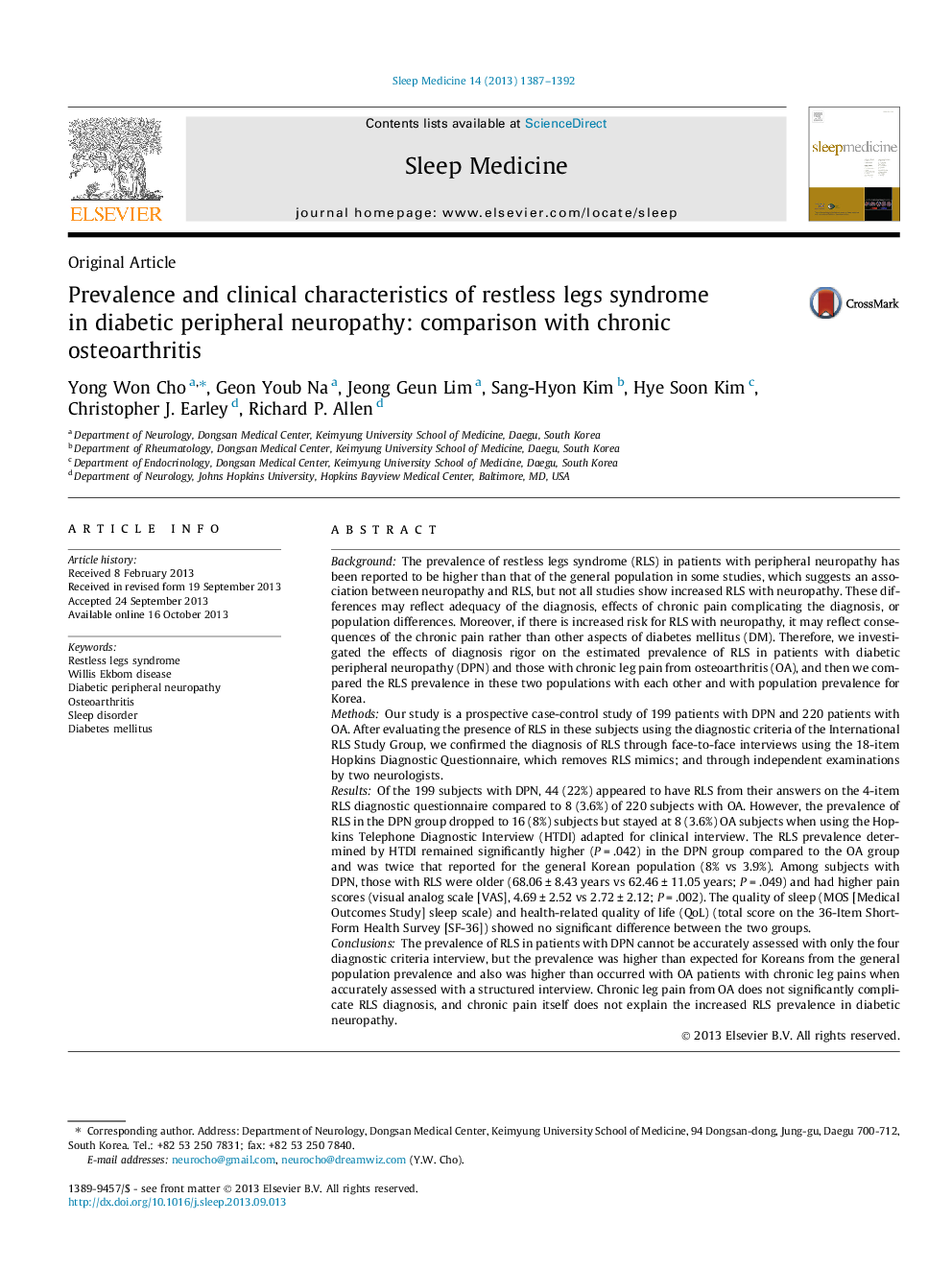| کد مقاله | کد نشریه | سال انتشار | مقاله انگلیسی | نسخه تمام متن |
|---|---|---|---|---|
| 6061050 | 1200253 | 2013 | 6 صفحه PDF | دانلود رایگان |
BackgroundThe prevalence of restless legs syndrome (RLS) in patients with peripheral neuropathy has been reported to be higher than that of the general population in some studies, which suggests an association between neuropathy and RLS, but not all studies show increased RLS with neuropathy. These differences may reflect adequacy of the diagnosis, effects of chronic pain complicating the diagnosis, or population differences. Moreover, if there is increased risk for RLS with neuropathy, it may reflect consequences of the chronic pain rather than other aspects of diabetes mellitus (DM). Therefore, we investigated the effects of diagnosis rigor on the estimated prevalence of RLS in patients with diabetic peripheral neuropathy (DPN) and those with chronic leg pain from osteoarthritis (OA), and then we compared the RLS prevalence in these two populations with each other and with population prevalence for Korea.MethodsOur study is a prospective case-control study of 199 patients with DPN and 220 patients with OA. After evaluating the presence of RLS in these subjects using the diagnostic criteria of the International RLS Study Group, we confirmed the diagnosis of RLS through face-to-face interviews using the 18-item Hopkins Diagnostic Questionnaire, which removes RLS mimics; and through independent examinations by two neurologists.ResultsOf the 199 subjects with DPN, 44 (22%) appeared to have RLS from their answers on the 4-item RLS diagnostic questionnaire compared to 8 (3.6%) of 220 subjects with OA. However, the prevalence of RLS in the DPN group dropped to 16 (8%) subjects but stayed at 8 (3.6%) OA subjects when using the Hopkins Telephone Diagnostic Interview (HTDI) adapted for clinical interview. The RLS prevalence determined by HTDI remained significantly higher (P = .042) in the DPN group compared to the OA group and was twice that reported for the general Korean population (8% vs 3.9%). Among subjects with DPN, those with RLS were older (68.06 ± 8.43 years vs 62.46 ± 11.05 years; P = .049) and had higher pain scores (visual analog scale [VAS], 4.69 ± 2.52 vs 2.72 ± 2.12; P = .002). The quality of sleep (MOS [Medical Outcomes Study] sleep scale) and health-related quality of life (QoL) (total score on the 36-Item Short-Form Health Survey [SF-36]) showed no significant difference between the two groups.ConclusionsThe prevalence of RLS in patients with DPN cannot be accurately assessed with only the four diagnostic criteria interview, but the prevalence was higher than expected for Koreans from the general population prevalence and also was higher than occurred with OA patients with chronic leg pains when accurately assessed with a structured interview. Chronic leg pain from OA does not significantly complicate RLS diagnosis, and chronic pain itself does not explain the increased RLS prevalence in diabetic neuropathy.
Journal: Sleep Medicine - Volume 14, Issue 12, December 2013, Pages 1387-1392
